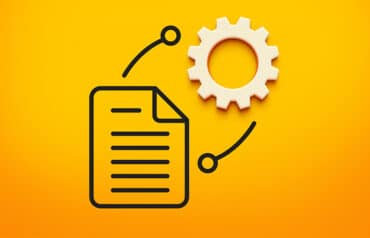With the shift toward remote collaboration, the legal industry is witnessing a significant evolution from the traditional “pen-holder” approach to document management toward a more dynamic, collaborative method of co-authoring legal documents. This transformation, once driven by cloud-based tools, is now being supercharged by the integration of artificial intelligence.

Table of contents
Law firms, traditionally reliant on face-to-face interactions and paper-heavy processes, now face a pressing need to adapt to a digital-first approach. This is particularly crucial in the realm of document creation and management, where the efficiency, accuracy, and speed of document preparation can significantly affect client service and case outcomes. The modern challenge is no longer just finding the right tools, but seamlessly integrating human collaboration with intelligent automation.
Adapting to Modern Communication and Intelligent Document Management Needs
Real-time communications through applications such as Microsoft Teams is fast becoming the norm. Collaborative document management technologies and intelligent document automation are streamlining internal processes and facilitating efficient document handling in law firms. This shift toward instantaneous interaction contrasts with the more deliberate pace required within traditional Document Management Systems (DMS). While DMS platforms still excel at organizing and safeguarding extensive collections of legal documents, providing a foundational structure for storage and retrieval, the introduction of AI-driven co-authoring tools is transforming this dynamic.
Instead of navigating a complex landscape of disconnected tools, legal professionals are increasingly using integrated platforms that embed AI capabilities directly within the DMS. These advancements are part of the legal industry’s digital transformation and are changing the way law firms operate. By adopting collaborative document management technologies and intelligent document automation, firms can streamline internal processes and facilitate efficient document handling. This eliminates the repetitive handling of files and other inefficiencies that occurred when moving documents in and out of the DMS. Firms are finding a new balance by leveraging the robust features of traditional DMS platforms alongside powerful, AI-native collaboration tools, ensuring document integrity is maintained without impeding the flow of communication or the speed of work.
Rethinking the Pen-Holder Model: The Rise of the AI Co-Pilot
Traditionally, legal documents have been managed by a single person responsible for integrating various legal perspectives into a cohesive document—the “pen-holder.” The pen-holder’s traditional role served as a centralized control point in legal document management traditionally, overseeing approvals, ensuring accuracy, and maintaining compliance, especially when dealing with complex documents requiring input from multiple specialists. While this model simplified control and maintained document integrity, it can create bottlenecks and inefficiencies, particularly with complex documents that need contributions from multiple specialists. The risk of conflicting changes and the slowness of serial revisions have prompted a reevaluation of this approach, particularly as smaller, more aligned teams and even AI systems become involved. In such cases, collaborative efforts, both human and automated, lead to more rapid identification and resolution of key issues, rendering the old-school pen-holder method less efficient.
The modern “pen-holder” is no longer a single person but rather an integrated system where human expertise is augmented by an AI co-pilot. This AI can perform the initial heavy lifting of drafting, data verification, and research, freeing up the legal team to focus on strategy and negotiation.
The Shift Toward AI-Powered Co-Authoring
The Evolution of Specialist Contributions. When documents require specialized input, the traditional approach has often been to view these contributions as simple “approvals” or sign-offs. While this method relies heavily on version control for clarity and accountability, it comes at the cost of flexibility and real-time collaboration.
The advent of AI-powered co-authoring platforms, such as Copilot for Microsoft 365, offers a stark contrast. These tools enable all participants to view and edit the live document simultaneously, while also leveraging AI to:
- Flag Inconsistencies: The AI can instantly highlight conflicting clauses or factual discrepancies introduced by different contributors.
- Suggest Language: Based on a firm’s knowledge base and precedent, the AI can suggest precise legal language for a specialist’s contribution.
- Generate Summaries: For a quick review, an AI can generate a summary of all changes made by each contributor, providing a clear overview without requiring a line-by-line manual check.
These collaborative document editing tools streamline document preparation and support real-time collaboration among multiple parties, making the process of document creation and legal document drafting more efficient and secure.
This approach not only streamlines the editing process but also fosters a more collaborative environment, where ideas and corrections are shared and enhanced in real time.
True Collaboration Requires a Cultural and Technological Shift
The transition to collaborative legal document co-authoring requires not only technological adaptation but also a cultural shift. The ingrained preference for presenting polished “final” drafts and the reluctance to engage with early-stage collaborative drafts highlight the need for a change in mindset. This shift also requires new training, as legal professionals must learn to trust and effectively interact with AI systems to maximize their value.
Successfully navigating this transformation involves clear communication, setting expectations for AI-human teamwork, and fostering an environment that values collaboration over perfection. This shift offers the promise of increased efficiency, improved document quality, and a more responsive law practice. However, realizing the benefits depends on navigating the complexities of integrating human oversight with technological innovation.
Successfully Navigating the Digital Transformation
Integrating real-time collaborative tools with AI and existing legal DMS platforms is a key factor in navigating the legal industry’s digital transformation. Tools that enable attorneys to work together on documents in real time, with the support of an AI co-pilot, can significantly reduce the time for document drafting and review. The benefits of this integrated approach include:
- Faster Turnaround: Drastically reduced time for drafting, review, and client requests.
- Improved Accuracy: AI-powered checks and collective human review lead to fewer errors and higher-quality documents.
- Enhanced Security: The use of dedicated, secure platforms ensures that confidential client information remains protected.
The increased efficiency of these new technologies is prompting a broader change in the legal industry’s business model. As work becomes more automated, the traditional billable hour is giving way to fixed fees and value-based billing, rewarding firms for their expertise and the successful outcomes they achieve, not just the time they spend.
Image © iStockPhoto.com.

Sign up for Attorney at Work’s daily practice tips newsletter here and subscribe to our podcast, Attorney at Work Today.















